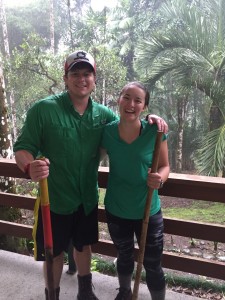Our month long program officially ended earlier today, and now I only have about two days left in Costa Rica. This place is beautiful and I’ve learned so much while here, but I am quite ready to be back in good ol’ Texas.
In the past week or so, time flew by especially fast, with a lot of our time being dedicated to our research projects. As a recap, our project was looking at the mutualistic relationship between Cecropia trees and Azteca ants. After sorting out all the kinks and such, or primary research question ended up being “does age of successional forest growth and distance to the nearest Cecropia neighbor contribute to percent of occupation of Azteca ants in Cecropia trees?” While we met many limitations, the biggest one being time, we still were able to look at a reasonable amount of Cecropia trees (sample size = 65). For each Cecropia individual, we ended up taking a few different measurements and observations. First, we would measure the distance to the next closest Cecropia. The purpose of this was to see whether distance between individuals would have an impact on ant colonization. We would also observe whether the leaves were damaged by herbivores and to what extent. This became a measure of level of herbivory, which we measured as minor, medium, or major. This served to show whether ants played role in protecting the tree from herbivory, if ants were present. Lastly, of course, we observed whether or not ants were present on each individual. This task was trickier than originally thought. Agitating trees for a response became nearly impossible with the inability to go off trail. So we had to resort to looking towards the tree top where ants would patrol the leaves, usually having to look upward in 10×42 strength binoculars at a tree that could be 15 m in height at times. Talk about tricky! While this measurement came with its limitations, it was important to do our best at identifying ant presence, as this measure was quite important to the study.
Our results ended up showing us that the distance between Cecropia was shorter when ants were present. This result was shown to be significant after running a t-test for equality of means. Also, when ants were present, the level of herbivory was lower than when they were absent. This was also a significant result. Within our abandoned pasture (0-10 years old) section of transect, there was the highest percentage of ant occupancy of the three forest growth types. Within that abandoned pasture first growth, the distance to nearest neighbor was the shortest and the level of herbivory was the lowest of the three growths types. My partner and I believe that these results show that the age of successional forest growth and distance to the nearest neighbor might play a role in how many Cecropia are occupied by Azteca ants. We assume that because there are more Cecropia in this area (there were 41 trees in this section) and the distances between trees are shorter than in other areas, there are more potential source populations for colonization to other trees or saplings. The greatest amount of ant occupation in this land type contributes to this assumption (31.7% of Cecropia in this growth type were occupied).

Lex and I after our first attempt at collecting data (we got caught in a downpour and had to turn around)
Over all, this research required a lot of time and effort, and I’m thankful for everyone who worked with me and remained patient. (I know he won’t read this, but a special thank you to my partner Lex!) Beyond just the research project, this whole experience has been incredibly valuable and the things I have learned with stick with me for longer than they ever would from a normal classroom setting. I can’t believe how quickly this all went by, departing will be quite bittersweet. Hopefully this isn’t good bye to Costa Rica, just a see ya later.